
Transforming Workplace Safety with OSHA's National Emphasis Program
In just seven months since establishing a National Emphasis Program (NEP) focused on warehousing and distribution center operations, OSHA conducted 623 inspections and proposed $2.4 million in penalties, sending a clear message about the importance of compliance and safety.
The most frequently cited violations involved powered industrial trucks, including forklifts. Many businesses were found lacking in operator training and equipment maintenance. These violations underscore the importance of adhering to OSHA's safety standards.
Understanding OSHA's National Emphasis Program
The Occupational Safety and Health Administration (OSHA) launched the NEP to target high-hazard industries, focusing on warehousing and distribution centers. By increasing inspections and enforcing safety standards, the program aims to reduce workplace injuries by addressing common issues such as improper use of powered industrial trucks, poor maintenance practices, and inadequate worker training.
The NEP comprises several key components:
- More frequent inspections in targeted industries.
- Rigorous enforcement of existing safety standards.
- Proper training for workers operating industrial equipment.
Non-compliance can lead to hefty fines, making it crucial for companies to prioritize safety and compliance. Several companies have already faced significant penalties due to NEP inspections. For example, a distribution center in Ohio was fined $150,000 for multiple safety violations, including inadequate forklift training and failure to maintain equipment.
Powered Industrial Trucks and Safety
Powered industrial trucks, including forklifts, are critical in warehousing and distribution but pose significant risks if not properly managed.
- OSHA requires that all forklift operators be adequately trained and certified. Regular training sessions can prevent accidents and ensure compliance with OSHA standards.
- Businesses should implement a routine maintenance schedule and conduct daily inspections to identify and address potential issues.
- Establishing and following safe operating procedures for forklifts can significantly reduce the risk of accidents. These procedures include proper loading and unloading techniques, speed limits, and safe driving practices.
Enhancing Workplace Safety
Improving workplace safety is not just about compliance; it's about creating a culture of safety that protects employees and enhances productivity.
- Comprehensive safety programs should include regular training, safety audits, and emergency response plans.
- Employees should be encouraged to report hazards, participate in safety training, and contribute to safety planning.
- Leveraging technology can enhance workplace safety. For example, wearable safety devices can monitor worker movements and alert them to potential hazards. Automated systems can also enforce safety protocols and track compliance.
- Leadership commitment is essential for building a culture of safety. Business leaders should prioritize safety, allocate resources, and set an example for their employees.
- Continuous improvement is key to maintaining a safe workplace. Regularly reviewing and updating safety programs, conducting safety audits, and staying informed about the latest best practices can help businesses stay compliant and protect their employees.
For further guidance and support, contact our risk management team for valuable insights and help developing and implementing effective safety programs tailored to your business needs.
Featured News & Insights

The manufacturing industry is changing fast. With record-breaking investments in new facilities, cutting-edge technology, and a push for smarter, more sustainable operations, there’s a lot to be...

Manufacturing is a cornerstone of the global economy, encompassing industries that transform raw materials into finished goods. From automotive and aerospace to electronics and consumer products, the...

A recent Forbes story on key topics for manufacturers going into 2025 mentioned several, but the overall theme was the advancement of AI technologies in the manufacturing industry. Following is a...